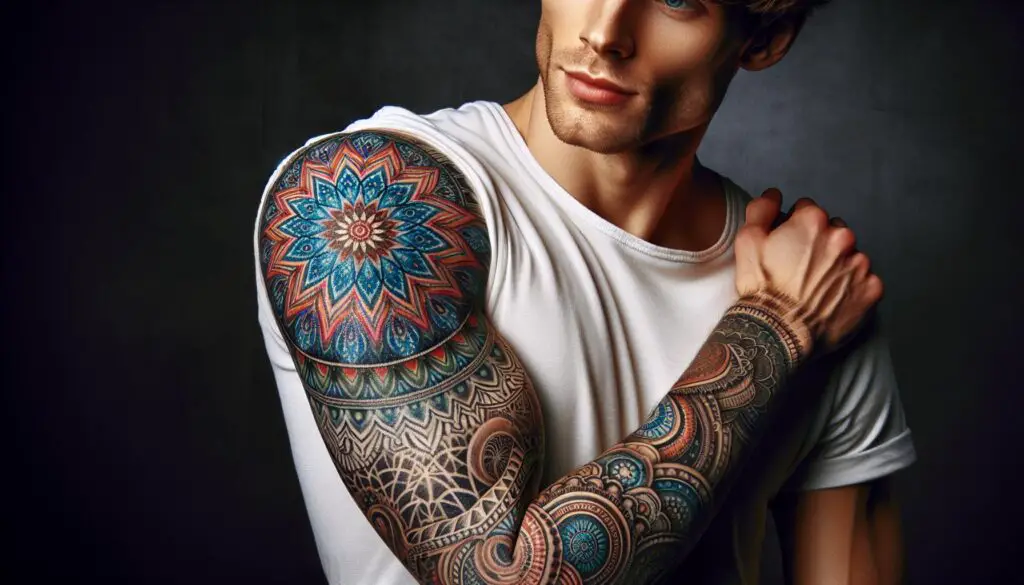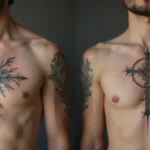Mandala tattoos have surged in popularity, captivating enthusiasts with their intricate designs and deep symbolism. We’re drawn to these mesmerizing patterns not just for their beauty but for the meaning they carry, reflecting balance, unity, and personal growth.
Choosing a mandala tattoo means embracing a timeless art form that resonates on a spiritual level. Our exploration of this stunning tattoo style will guide you through its origins, significance, and the endless possibilities it offers for personal expression. Whether you’re contemplating your first mandala tattoo or seeking to deepen your appreciation, we’re here to inspire your next ink journey.
Understanding Mandala Tattoos
Mandala tattoos are more than just beautiful designs; they hold deep meanings and cultural significance. Let’s explore where they come from and what they symbolize.
Exploring the Origins
Mandalas originated in ancient spiritual traditions, particularly within Hinduism and Buddhism. These intricate designs were used as tools for meditation and spiritual guidance. Over time, mandalas spread across different cultures, each adding their unique touch. Today, mandala tattoos symbolize harmony and balance, reflecting the universal connection among all things. They have become a popular choice for those seeking a meaningful and visually stunning tattoo.
Decoding the Symbolism
Every mandala tattoo carries rich symbolism that goes beyond its aesthetic appeal. The circular shape represents unity and completeness, while the complex patterns signify the layers of life’s journey. Common elements like lotus flowers, geometric shapes, and sacred geometry enhance the tattoo’s meaning. For example, a lotus flower often symbolizes purity and enlightenment, whereas geometric patterns can represent structure and order. By choosing exact symbols, individuals can express their personal growth, resilience, and spiritual beliefs through their mandala tattoos.
Selecting the Perfect Design
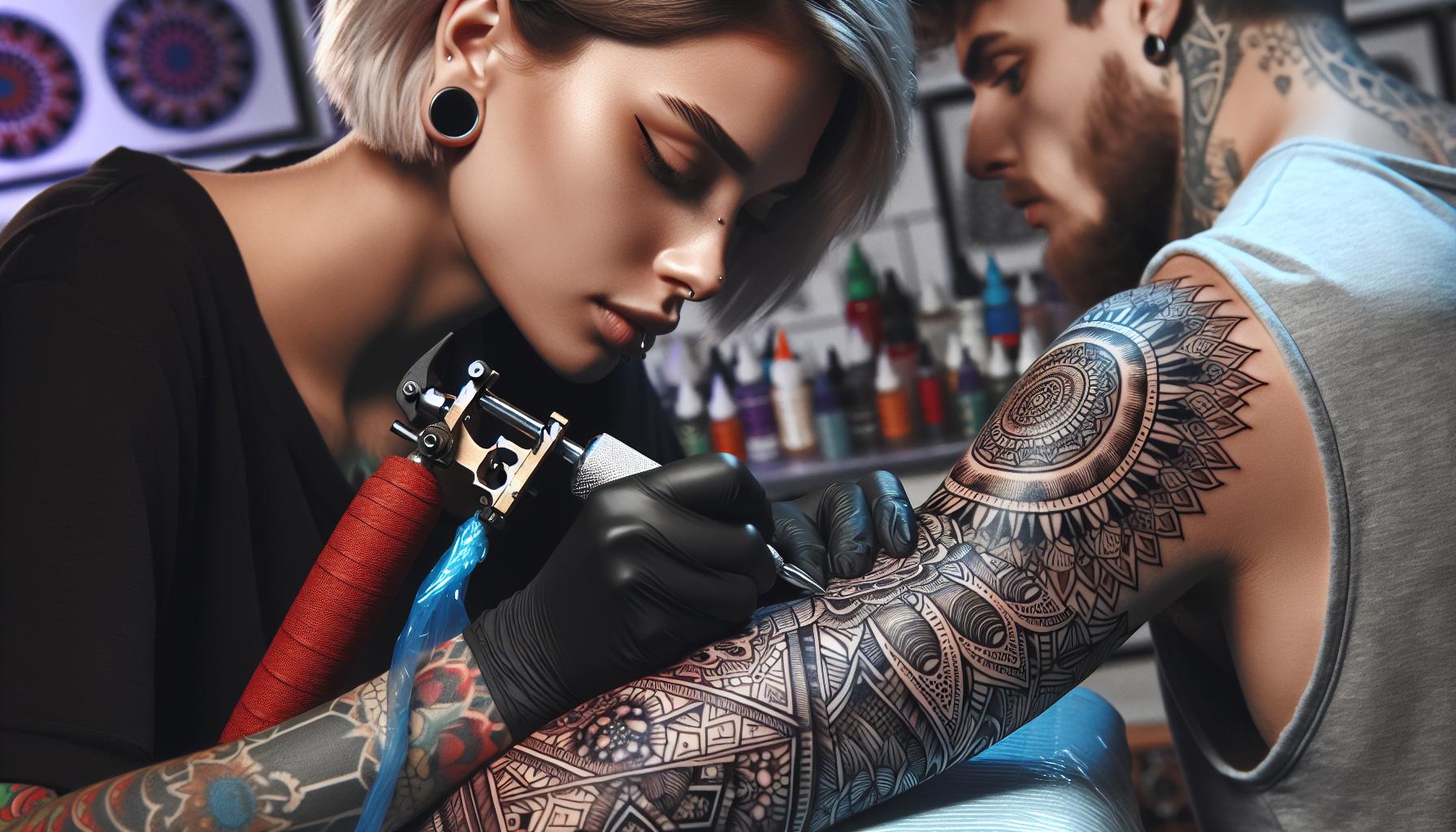
Choosing the right mandala tattoo design involves considering both its meaning and style. Let’s explore the different styles and customization options to help you find the perfect match.
Traditional vs. Contemporary Styles
Understanding the distinction between traditional and contemporary mandala styles is crucial for selecting a design that resonates with you.
- Traditional Mandalas: Focus on time-honored patterns and geometric precision. These designs emphasize symmetry and often incorporate shapes like circles, triangles, and squares to symbolize unity, balance, and stability.
- Contemporary Mandalas: Embrace modern aesthetics with unique twists on classic patterns. These styles may include abstract elements, vibrant colors, and intricate details, offering a fresh take while retaining the essential symbolism of mandalas.
Customizing Your Mandala
Personalizing your mandala tattoo ensures it reflects your individual journey and beliefs.
- Incorporate Personal Symbols: Add elements that hold special meaning to you, such as lotus flowers for purity or exact geometric shapes that represent your values.
- Choose Your Color Palette: Select colors that resonate with your personal energy and the symbolism you wish to convey, improving the overall impact of the design.
- Adjust Complexity Levels: Decide whether you prefer a simple, clean design or a more intricate pattern with multiple layers, allowing your tattoo to suit your aesthetic preferences and pain tolerance.
- Consult with Your Tattoo Artist: Collaborate with a skilled artist to bring your unique vision to life, ensuring that every detail aligns with your desired symbolism and style.
Choosing the Ideal Placement
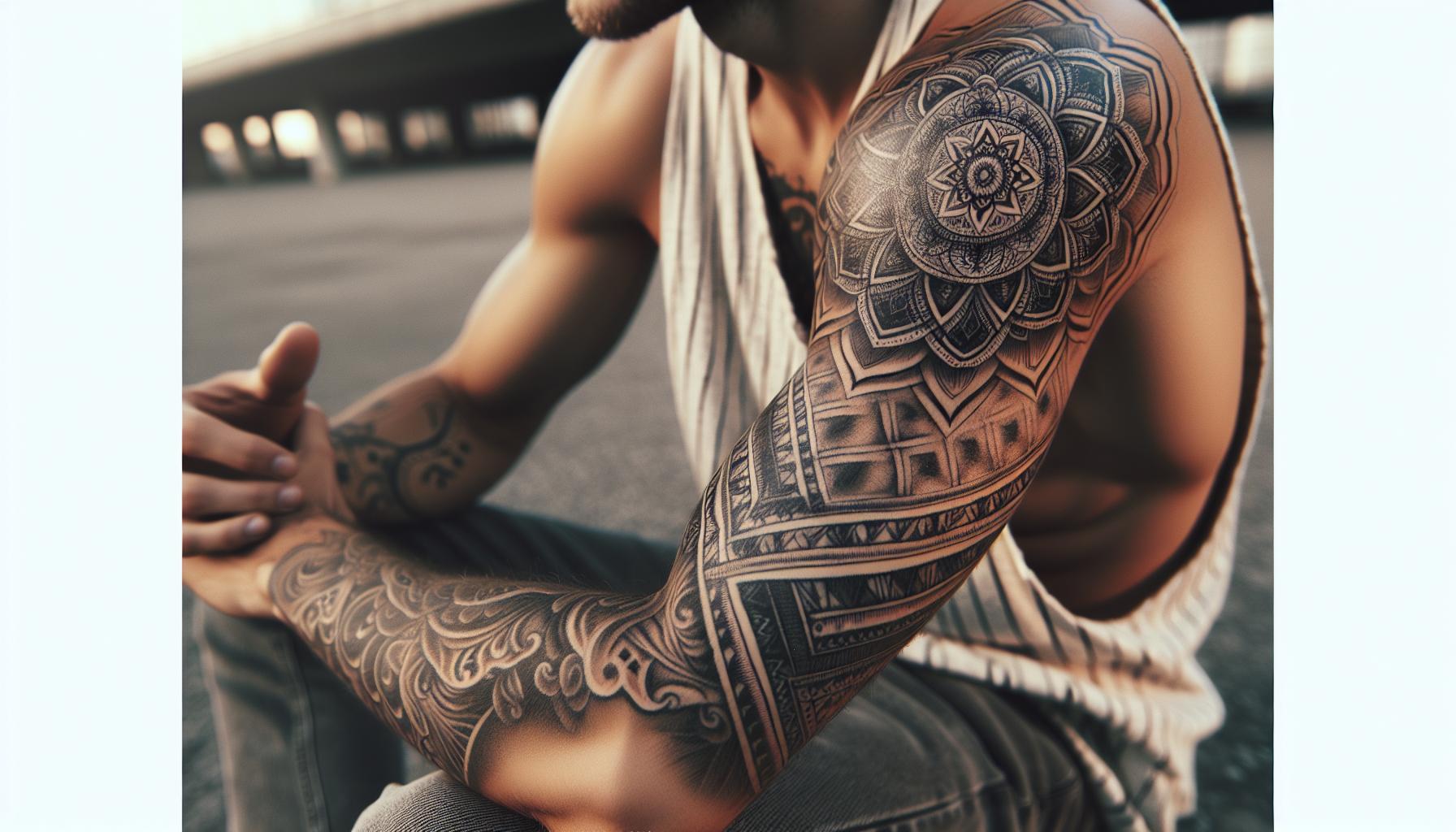
Selecting the perfect spot for your mandala tattoo is essential for both its aesthetic appeal and personal significance. Let’s explore the most popular body locations and how size and detail play a role in your decision.
Popular Body Locations
- Back and Chest: We find these areas perfect for larger, more intricate mandala designs. The expansive, flat surface allows the symmetry and detail to shine, symbolizing our inner strength and emotional balance.
- Shoulder, Forearms, and Thighs: These spots offer versatility, accommodating both small and large designs. They remain easily visible, letting us showcase our tattoos, yet can be effortlessly covered when necessary.
- Arms and Legs: These regions provide ample space for detailed mandalas. Whether we want our tattoo to be a personal statement or something to display, arms and legs allow for both hiding and showing as desired.
Considering Size and Detail
- Design Complexity: We take into account the mandala’s intricacy when choosing its placement. Highly detailed tattoos thrive on larger surfaces like the back and chest, ensuring each element is clear and vibrant.
- Visibility Preferences: Deciding between a visible or concealed placement helps us determine the right size. If we prefer showcasing our tattoo, areas like the forearms and shoulders are ideal. For more personal meanings, places like the thigh or upper arm work well.
- Proportion and Balance: Ensuring the mandala’s size complements the body part is crucial. A well-proportioned tattoo enhances our natural curves and lines, making the design look harmonious with our body.
Finding a Skilled Tattoo Artist
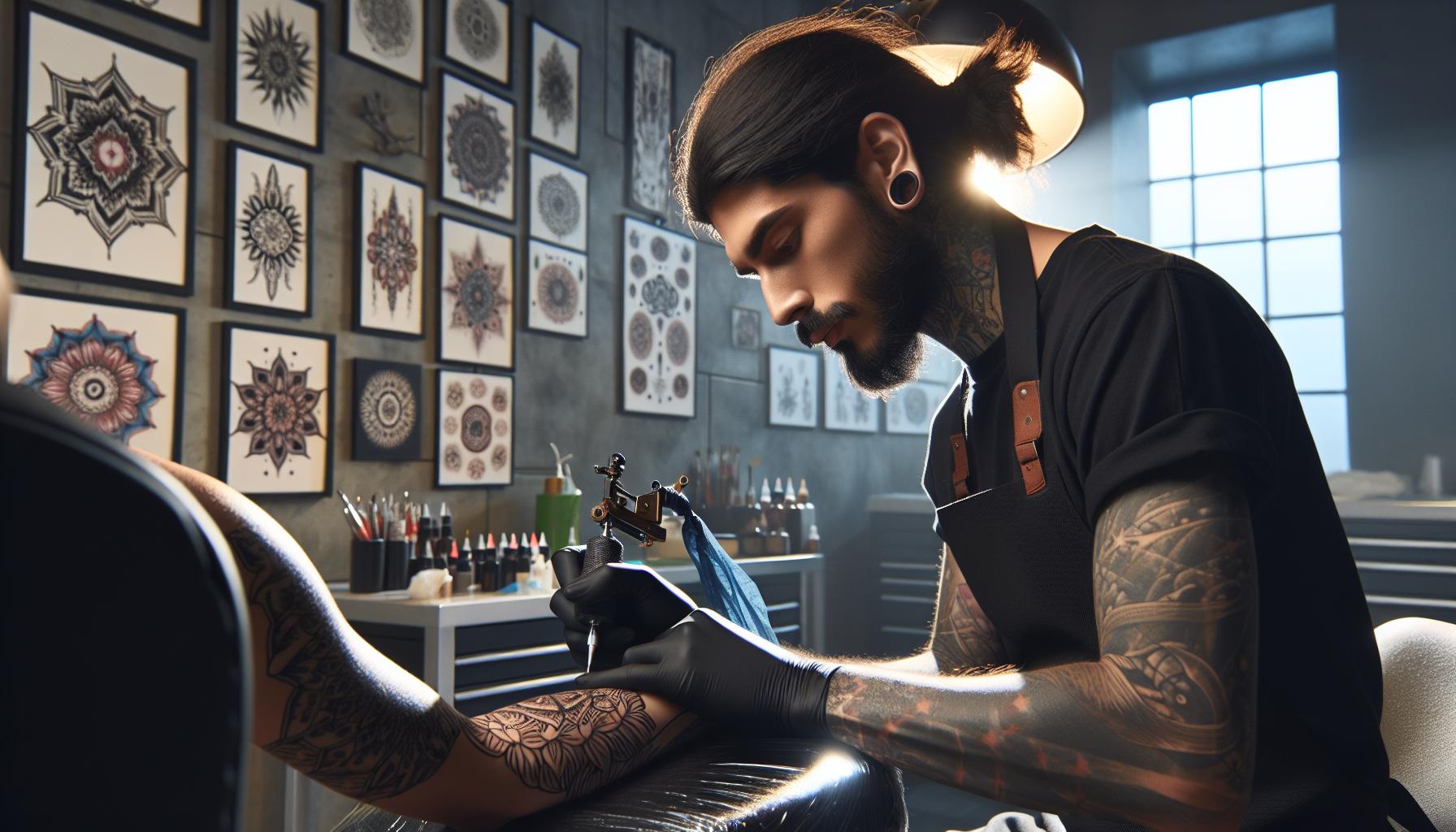
Choosing the right tattoo artist ensures your mandala design is both beautiful and meaningful. Let’s explore how we can find a skilled professional for our tattoo journey.
Evaluating Portfolios
Examining an artist’s portfolio is essential to gauge their expertise. We should look for intricate and detailed mandala designs that resonate with our vision. Assess the symmetry and precision in their work to ensure they can handle complex patterns. For example, an artist who consistently showcases vibrant geometric shapes and flawless line work demonstrates their capability. Also, browsing through their social media and website can provide a comprehensive view of their style and versatility.
Importance of Experience
Experience plays a crucial role when selecting a tattoo artist for a mandala design. A seasoned artist understands the nuances of intricate patterns and can adapt the design to fit our body’s contours seamlessly. We should prioritize artists who have a strong background in creating mandalas, as their familiarity with the symbolism and techniques ensures a high-quality outcome. Also, experienced tattooists can offer valuable advice on placement and sizing, improving both the aesthetic and personal significance of our tattoo.
Caring for Your Mandala Tattoo
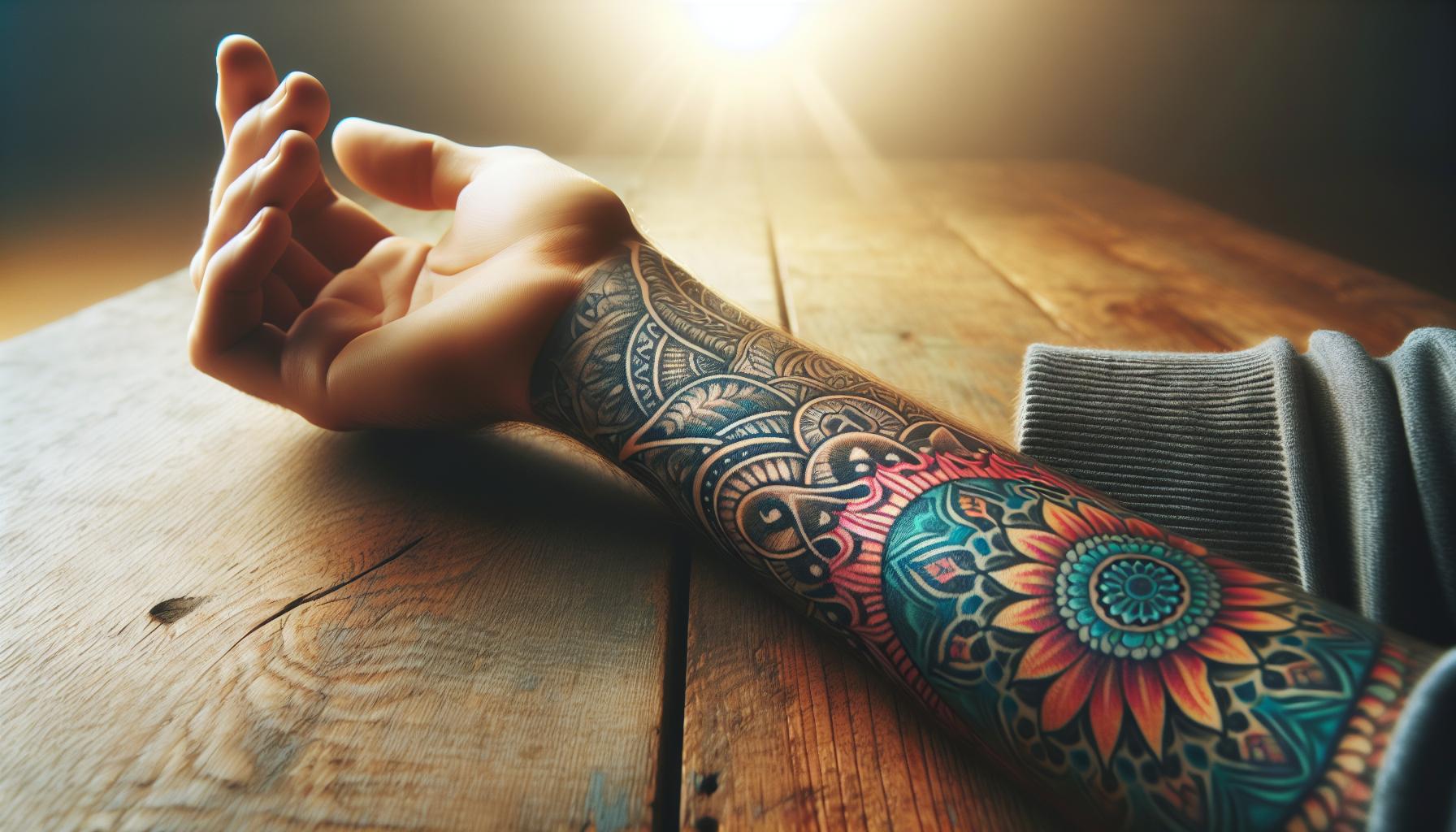
Proper care ensures your mandala tattoo remains vibrant and heals beautifully. Follow these essential steps to maintain its intricate details and lasting appeal.
Immediate Aftercare
- Clean the Tattoo Gently
We wash the tattoo with mild fragrance-free soap and lukewarm water. This helps prevent infection and keeps the area clean.
- Keep It Covered Initially
We cover the tattoo with a sterile bandage for the first few hours, as advised by our tattoo artist. This protects it from bacteria and debris.
- Moisturize Regularly
We apply a thin layer of antibiotic ointment or a non-scented, alcohol-free moisturizer. This keeps the skin hydrated and supports the healing process.
- Shield from Sunlight
We avoid direct sunlight and refrain from soaking the tattoo in water for at least two weeks. This prevents fading and reduces the risk of infection.
- Don’t Pick or Scratch
We let the tattoo heal naturally without touching it. Picking or scratching can lead to scarring and disrupt the healing.
Long-Term Maintenance Tips
- Protect with Sunscreen
We apply a high SPF sunscreen to the tattoo regularly. This shields the colors from fading due to sun exposure.
- Keep the Skin Hydrated
We moisturize the tattooed area daily. Consistently hydrated skin maintains the tattoo’s sharpness and vibrancy.
- Avoid Harsh Chemicals
We steer clear of harsh skincare products around the tattoo. Chemicals can irritate the skin and degrade the ink over time.
- Schedule Touch-Ups if Needed
We consider touch-ups for any fading or blurring. Regular maintenance keeps the mandala’s intricate details clear and defined.
- Maintain a Healthy Lifestyle
We support our skin’s health by staying hydrated and eating a balanced diet. Healthy skin enhances the appearance and longevity of our tattoo.
- Regular Exfoliation
We gently exfoliate the tattooed area once a week. This removes dead skin cells and promotes new, healthy skin growth, keeping the tattoo looking fresh.
By following these care practices, we ensure our mandala tattoo remains a stunning and meaningful piece of art for years to come.
Conclusion
Embracing a mandala tattoo allows us to carry a symbol of balance and personal growth with us every day. It’s more than just a beautiful design; it represents our journey and values. By carefully selecting the right artist and design, we ensure our tattoo truly reflects who we are. Taking proper care of our mandala ensures its lasting vibrancy and significance. Whether you’re new to tattoos or adding to your collection, mandala tattoos offer a meaningful and stunning expression of self.
Frequently Asked Questions
What are mandala tattoos?
Mandala tattoos are intricate designs inspired by traditional spiritual symbols. They feature circular patterns that represent unity, balance, and completeness. Often decorated with geometric shapes and elements like lotus flowers, mandala tattoos are not only visually stunning but also hold deep personal and spiritual significance for the wearer.
What is the symbolism behind mandala tattoos?
Mandala tattoos symbolize balance, unity, and personal growth. The circular shape represents wholeness and harmony, while the complex patterns reflect the journey of life. Common elements like lotus flowers signify purity and spiritual awakening, making mandalas a meaningful choice for expressing resilience, spirituality, and personal development.
Where do mandala tattoos originate from?
Mandala tattoos trace their origins to ancient Hindu and Buddhist traditions. In these cultures, mandalas were used as tools for meditation and spiritual guidance. Over time, mandalas evolved across various cultures, symbolizing harmony and balance, and have become a popular tattoo choice for those seeking both aesthetic beauty and profound meaning.
How do I choose a mandala tattoo design?
Choosing a mandala tattoo involves considering both the design’s meaning and your personal style. Decide between traditional mandalas with classic patterns or contemporary designs with modern twists. Customize your tattoo by incorporating personal symbols, selecting a color palette that resonates with you, and adjusting the complexity to ensure the design reflects your unique journey and preferences.
What are the popular placements for mandala tattoos?
Popular placements for mandala tattoos include the back, chest, shoulders, forearms, thighs, arms, and legs. The size and detail of the design influence the best placement choice. Larger, more intricate mandalas look great on expansive areas like the back or chest, while smaller designs can be placed on more visible spots like the forearms or ankles, ensuring the tattoo complements your body’s natural lines.
How do I select the right tattoo artist for a mandala tattoo?
Selecting the right tattoo artist involves evaluating their portfolio for symmetry and precision in mandala designs. Look for artists with experience in intricate patterns and a strong understanding of mandala symbolism. A skilled artist will provide valuable advice on placement and sizing, ensuring your mandala tattoo is both aesthetically pleasing and personally meaningful.
How should I care for my mandala tattoo?
Caring for your mandala tattoo involves proper aftercare and long-term maintenance. Immediately after getting tattooed, gently clean the area, keep it moisturized, and protect it from sunlight. Avoid picking or scratching the tattoo. For long-term care, apply sunscreen, keep the skin hydrated, avoid harsh chemicals, and schedule touch-ups if needed to maintain the tattoo’s vibrancy and detail.
Can I customize my mandala tattoo design?
Yes, mandala tattoos are highly customizable. You can incorporate personal symbols, choose colors that resonate with you, and adjust the design’s complexity to reflect your personal story. Customization allows you to create a unique mandala that not only looks beautiful but also holds significant personal meaning, making your tattoo truly one-of-a-kind.
What is the difference between traditional and contemporary mandalas?
Traditional mandalas focus on time-honored patterns and geometric precision, rooted in ancient spiritual practices. Contemporary mandalas embrace modern aesthetics, often incorporating unique twists and varied artistic styles. While traditional designs emphasize symmetry and spiritual symbolism, contemporary mandalas offer more flexibility and personal expression, catering to diverse tastes and preferences.
Why are mandala tattoos so popular?
Mandala tattoos are popular because of their stunning visual appeal and deep symbolic meaning. They represent balance, unity, and personal growth, resonating with many who seek tattoos with purpose and beauty. Their versatile designs can be customized to reflect individual stories and spiritual beliefs, making mandala tattoos a meaningful and attractive choice for personal expression.

